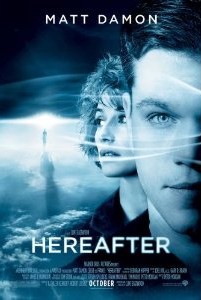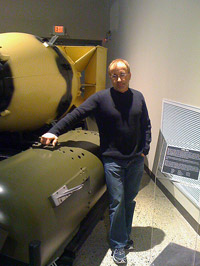
click to enlarge
On Saturday, February 5, 2011, my audio book producer John Wagner and I took a break from endless hours of my reading aloud (with John editing out my countless mistakes) my next book, The Believing Brain, which ironically includes chapters on UFOs, aliens, and conspiracy theories. Ironic because for this break John and I took what we thought would be an uneventful tour of the beautiful new National Museum of Nuclear Science and History in Albuquerque, New Mexico.
This is definitely a museum well worth visiting for a comprehensive tour of all things atomic. It was originally opened in 1969 as the Sandia Atomic Museum, but then changed in 1973 to the National Atomic Museum to include a broader history of the peaceful use of nuclear energy, and finally morphed into the new building that now houses the collection, which includes replicas of the Fat Man and Little Boy bombs (see photograph), along with a B-29, a B-52, an F-105, an A-7, an Atomic Cannon, a Titan II Rocket, a Minuteman Missile, a Jupiter Missile, a Thor Missile, and hundreds more smaller items inside the museum building itself, including these two amusing early uses of atomic energy for “health” purposes:
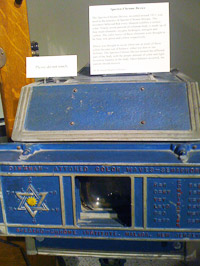
click to enlarge
1. The Spectro-Chrome Device, “invented around 1911, was used in the practice of Spectro-Chrome therapy. The inventors believed that every element exhibits a certain color. Ninety-seven percent of a human body is made up of four main elements: oxygen, hydrogen, nitrogen and carbon. The color waves of these elements were thought to be blue, red, green, and yellow respectively. Illness was thought to occur when one or more of these colors became out of balance, either too dim or too brilliant. The Spectro-Chrome Device treated the afflicted part of the body with the proper amount of color and light to restore balance in the body. Once balance occurred, the patient should recover.” The operative word here is “should”.
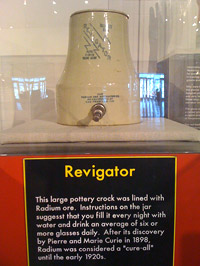
click to enlarge
2. The Revigator: “This large pottery crock was lined with Radium ore. Instructions on the jar suggest that you fill it every night with water and drink an average of six or more glasses daily. After its discovery by Pierre and Marie Curie in 1898, Radium was considered a ‘cure-all’ until the early 1920s.” The operative word here is “crock”.
We were also quite impressed with the array of nuclear-tipped missiles, including these two (see below), one of which had been in space and survived the reentry. Can you tell which one?
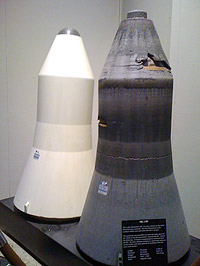
click to enlarge
Then something really weird happened. As John and I were strolling along the exhibits talking about this and that, I wondered out loud if they had any examples of the sand that was turned into glass in the Trinity atomic bomb test explosion on July 16, 1945 at White Sands, New Mexico. Just then the museum docent who had kindly joined us to offer more detailed narratives to accompany the printed plaques, explained that they did, indeed, have a display of said sand-to-glass fusion, and there it was, beautiful in its horrific creation. We chatted it up with the docent for a time, at which point I asked if it is possible to go to White Sands and see the glass in situ. She said, “no, it has all been taken away.” I said, “who took it away, and where is it?” She responded rhetorically: “Right, who took it, where, and why?” I repeated the question and she repeated the rhetorical answer.
“Uh, what are you saying? Someone secreted it away?” “Yes, right, it’s gone and no one knows where,” she explained unhelpfully. “But someone must know,” I pleaded.

click to enlarge
At this point she hinted that there are many government secrets still surrounding nuclear weapons. Of this I am quite certain, since governments do keep secrets in the interests of national security, but she seemed to be speaking of a different sort of secret. I probed for more examples of such secrets. “When you go outside,” she offered, “you will see a B-29 bomber, like the one that dropped the bombs on Hiroshima and Nagasaki. Look at the serial number on the tail. It says 451748. But if you go inside the cockpit and look behind the pilot seat you will find another serial number for that plane: 451749.”
“Okay, so someone messed up,” I suggested. “After all, the people who spray paint numbers on planes are probably not the engineers who design and build planes for Boeing. So what?”
“Well, I looked into that matter myself when I was restoring the plane,” she continued breathlessly, “and it turns out that plane number 451749 disappeared over the South China Sea in a mysterious explosion in the early 1950s. Supposedly one of the bombs armed itself inside the B-29 and then detonated itself.”
“Is that possible?” I queried, wondering just where this story was going but suspecting it was about to take a dramatic turn into conspiratorial waters.
“Have you ever heard of a bomb arming itself and then detonating itself?” she queried. I had to admit that I hadn’t, but I also signaled to her that I didn’t know much at all about bombs and what they are capable of doing, but then suggested that I could certainly imagine how the same people who spray paint the wrong serial number on the tail of a plane could easily screw up while arming a bomb and cause it to explode. Human error happens not infrequently in operating complex machinery.
“Well, I’ll tell you—that doesn’t happen,” she countered my feeble objections. “That plane was shot down or intentionally destroyed.” Okay, shot down. Intentionally destroyed. By whom, enemy fighter planes or an anti-aircraft missile over enemy territory? “No, it was destroyed by our own government.” Why? “Because the crew saw something.” What? What did they see? “Remember, this was not long after Roswell….”
Okay, here we go, we’re on my turf now! Aliens, UFOs, Roswell, New Mexico. The alien encounter in 1947. The crew, she said, probably had a UFO encounter of some sort, and they were silenced. “Wow, that’s incredible,” I enthused. “How can I look into this further?” At this point my erstwhile conspiratorialist grew quiet, warning me in a voice too fervent by half: “You can try but I wouldn’t get my hopes up. I made some calls myself and finally got a hold of a two-star general, who told me ‘I don’t know what happened and you don’t either.’”
“What did you take that to mean?,” I pushed. “He was telling me that if I didn’t drop my investigation of what really happened to plane number 451749, that Men-In-Black would come pay me a visit,” she explained unhesitatingly and with enough dramatis that I would get the message myself.
So…there it is. That’s all I know from my brief visit and having conducted no further investigations. If anyone reading this knows, or knows someone who knows…or who has a Friend-of-a-Friend who knows someone who knows what happened to B-29 plane number 451749, I would really like to know myself. And if there are any M.I.B. out there planning to come visit me, bring an extra pair of those cool black sunglasses for me.








